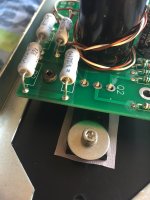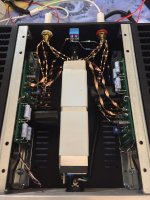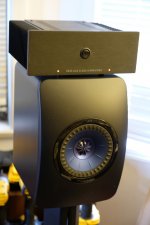It does feel like the bass is sometimes lacking, compared to my other amplifier (Sansui 1000A). Not sure if has anything to do with my speakers being 4 ohms or some other factor.
You could try replacing the output sound-coupling capacitor with 10,000uF/35V CDE cap. See the photo.
The thin, red, double-run cable, from the 24V connector to the switch, should be replaced with a much thicker pair of wires.
You could install the power supply inside the amp... and use very short wiring, for that ultimate ACA experience.
Attachments
ACA and Spatial Audio M4
I used to make the old Dynaco kits way back in the 1960s and thought it would be fun to get back into the game with the ACA amp kit. My speakers are the open baffle Spatial Hologram M4 speakers that have a 93db efficiency. Has anyone tried the ACA with these speakers or something similar that might give me some idea how they would interact? I would appreciate any input that might help me see if I want to go this route.
I used to make the old Dynaco kits way back in the 1960s and thought it would be fun to get back into the game with the ACA amp kit. My speakers are the open baffle Spatial Hologram M4 speakers that have a 93db efficiency. Has anyone tried the ACA with these speakers or something similar that might give me some idea how they would interact? I would appreciate any input that might help me see if I want to go this route.
Has anyone tried the ACA with these speakers or something similar that might give me some idea how they would interact? I would appreciate any input that might help me see if I want to go this route.
I used ACA with "Troels Gravesen OBL-15" which is also a 93-94 dB speaker. It worked very well. No problem playing loud enough. At that time I used the pre-amp part of a Nad M3 amp. This amp has a pre-amp out.
I used a 49K resistor for the LED supply instead of the 10K. It tones them down nicely,
though I built the amp in another case, so I don't see the LED's anyway, but 49K
works OK. I am able to use a passive preamp with the amp, but my DAC puts out around 1.5 volts, and my open baffle speakers are fairly efficient.
I prefer not to remove any parts or re-solder anything. I am counting my blessings that it works,
I am wondering if I could mount some type of material in the LED holes to diffuse? Just a thought.
I prefer not to remove any parts or re-solder anything. I am counting my blessings that it works,
I am wondering if I could mount some type of material in the LED holes to diffuse? Just a thought.
You could try roughing up the front surface of the LED with some fine sandpaper to diffuse. That's what I always do.
But I also suggest adding a resistor to dim the LED. It's relatively easy work.
Hey All, I hope you don't mind me asking a quick questions about adding CPU fans to cool my Amp Camp Amp...
I purchased the Amp Camp Amp parts kit and power supply, but not the chassis because I wanted to build my own.
I have assembled the kit and it sounds AMAZING! however the heatsinks I am using are getting pretty hot. I'm planning on buying some 24V CPU fans like these to help cool the heatsinks: https://www.amazon.co.uk/WINSINN-Br...u+fans&qid=1564069624&s=computers&sr=1-6&th=1.
Will I be able to simply connect the positive/ ground wires to the same power supply as the amplifier? Will the power supply be able to handle the additional load of 2 CPU fans?
Just something to consider when adding fans to audio equipment. The four measurements you need to consider are air flow (CFM), RPMs, dB level and fan size. The larger the fan the slower it can go for a given level of air flow, and the less noise it will make. You have to know the noise level before you purchase it. dB levels are a logarithmic measurement, remember that. Twice the number of decibels is NOT twice the noise, it is a lot more than that.
You want the lowest decibel level you can get since the fan will add a background hum to whatever you are listening to. There are other considerations as well. For example the bearings used by the fan, the cheap kind are sleeve bearings which are not what you want, they are noisier and break down faster. You need to have adequate ventilation holes to feed the fan with fresh air and provide exhaust to the hot air. You may want to provide some kind of filtration for the air to avoid severe dust build up. The electrical isolation needs have already been covered.
I like SilenX and Enermax case fan brands, choose well there is a lot to choose from, and buy at a computer parts store. Amazon does not provide a lot of needed numbers like dB counts for all its products. Good luck.
Hey All, I hope you don't mind me asking a quick questions about adding CPU fans to cool my Amp Camp Amp...
I purchased the Amp Camp Amp parts kit and power supply, but not the chassis because I wanted to build my own.
I have assembled the kit and it sounds AMAZING! however the heatsinks I am using are getting pretty hot. I'm planning on buying some 24V CPU fans like these to help cool the heatsinks: https://www.amazon.co.uk/WINSINN-Brushless-Computer-Receiver-Playstation/dp/B07GXB2F3R/ref=sr_1_6?keywords=quiet%2B24v%2Bcpu%2Bfans&qid=1564069624&s=computers&sr=1-6&th=1.
Will I be able to simply connect the positive/ ground wires to the same power supply as the amplifier? Will the power supply be able to handle the additional load of 2 CPU fans?
Before going down the path of fans, why not (or maybe you've already done this?) estimate whether your heat sink build plan will be up for the job? This question may be redundant if you're planning to hide the amp in an enclosed cupboard but if it's out in the open air - I'd suggest confirming whether you need to do anything at all. The amps naturally run warm and fans are not intended as part of the base design.
One path you could take is to check out Rod Elliott's site that includes a heatsink calculator that you could use:
ESP Download Page
(there are bound to be other options out on the web and comparing results never hurts to reveal anything weird due to hidden mathematics)
Here's Nelson's own commentary on the subject:
The Aleph-X Post #1858
You could use that data in the relevant spot in the spreadsheet referred above.
The store's ACA chassis:
Amp Camp Amp Chassis – diyAudio Store
is based on a 2U mini-dissipante chassis that is spec'd with, "Heatsinks One 40mm thick, 200mm deep, wave profile, black anodized aluminum heatsink per side". If your DIY heat sinks are in that ball park, you probably don't need to worry with a calc. Otherwise, you've got the means to work it out.
All the best..
Last edited:
I prefer not to remove any parts or re-solder anything. I am counting my blessings that it works,
I am wondering if I could mount some type of material in the LED holes to diffuse? Just a thought.
I posted earlier that I used Polymorph to make a diffuser, and it worked pretty well optically, though it was a little difficult to stuff into the hole and trim without scratching the panel.
Attachments
I think I'll have to build the wife an ACA to replace her little T-amp, she uses it to play internet radio on a squeezebox touch through a pair of KEF Reference 104Ab.
Not sure if it would drive the speakers though, but the T-Amp is only about 8 watts so should do a better job.
Am I looking for an excuse just to build one
Not sure if it would drive the speakers though, but the T-Amp is only about 8 watts so should do a better job.
Am I looking for an excuse just to build one
I definitely want something to do this fall/winter so was looking at some projects and the ACA kit is a possibility as is one of the Akitika kits, possibly the preamp, possibly the amp. Those are solid state of course but also seem to work well. Don't know if anyone has compared the Akitika kit with the ACA.Nyal, I assume you are retired if you built dynaco kits in the 60's. It is a lot of fun, as you know. Why don't you just jump in, the kits are not that expensive and they are nice to do.
Thanks for the input that at least I wouldn't be underpowered with the Hologram speakers.
That is not the same as having a truly balanced input though, correct?it's intrinsic in ones shown in Jim's build guide
tip: bridging switch
I have 2 ACA's I want to try out as balanced monoblocks, but my preamp only has single ended output. Can anyone recommend a good way to convert a single-ended output into a true balanced connection to do this?
Thanks.
Azookey, as far as I know there are true balanced preamps, in which the whole signal path is designed to work as a balanced unit with balanced (+) and (-) outs. And there are basically inbalanced preamps that provide a set of balanced outputs. You need to check the circuits to make sure you are getting the real thing.
Getting a true balance preamp does not have to be expensive. You need to locate someone selling PCBs for balanced preams (the schematics look like mirror images when comparing the (+) and (-) channels). For example you can get PCBs for an X BOSOZ (or BOSOZ X) form somewhere in croatia. If you find them they are not that expensive and it becomes a matter of getting the parts and building the thing. If you want a full balanced path, you have to do the same with the DAC.
I you wish to go cheap and try to fit an unbalanced preamp output to an XLR socket, there are RCA to XLR connectors available for purchase. I do not know if what you get may be called balanced or not, but you can use this signal as input into balanced mono ACAs. I have no heard anyone saying how they sound.
You have options, so look into it and decide what you want to do.
- Home
- Amplifiers
- Pass Labs
- Amp Camp Amp - ACA



